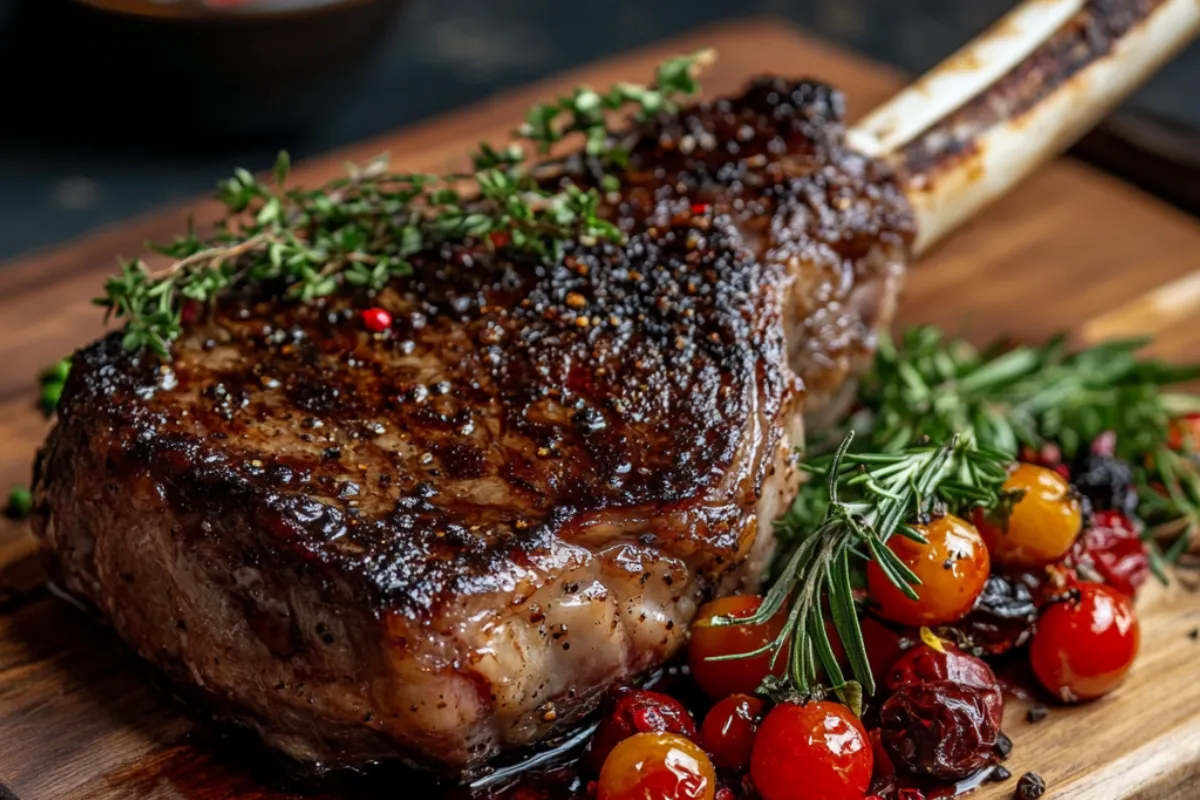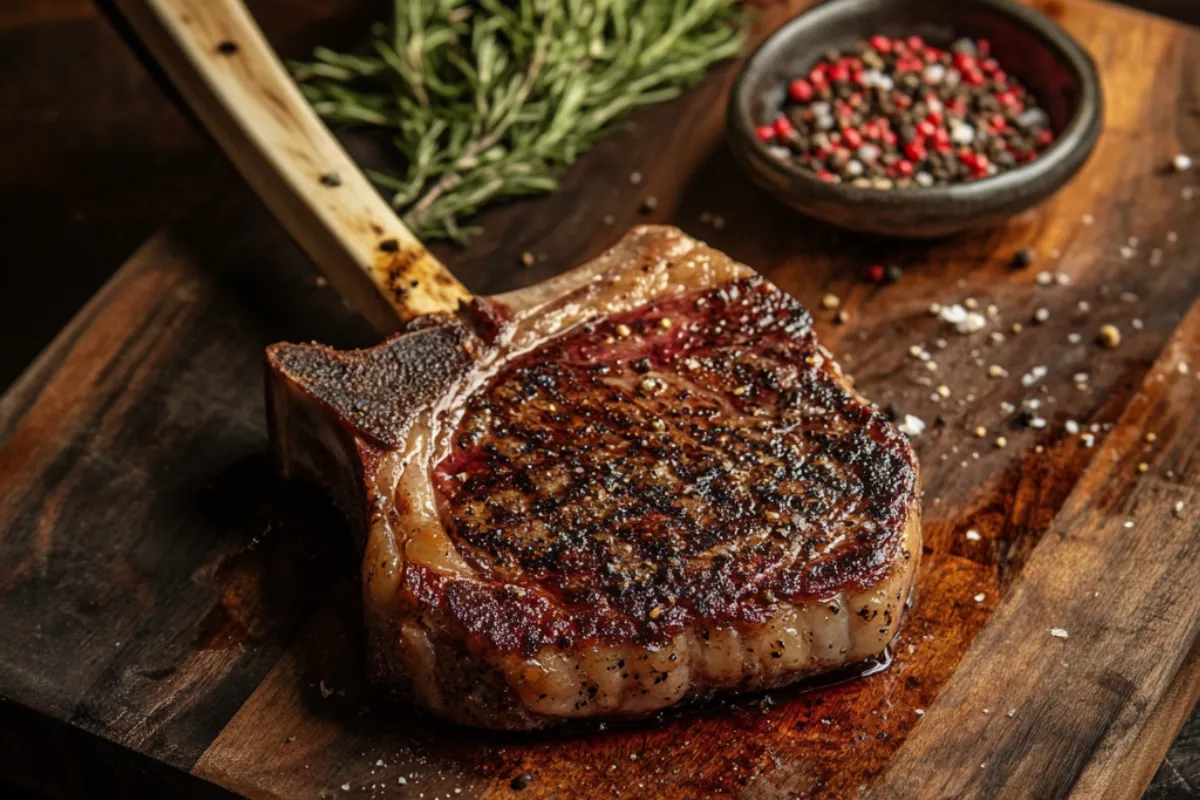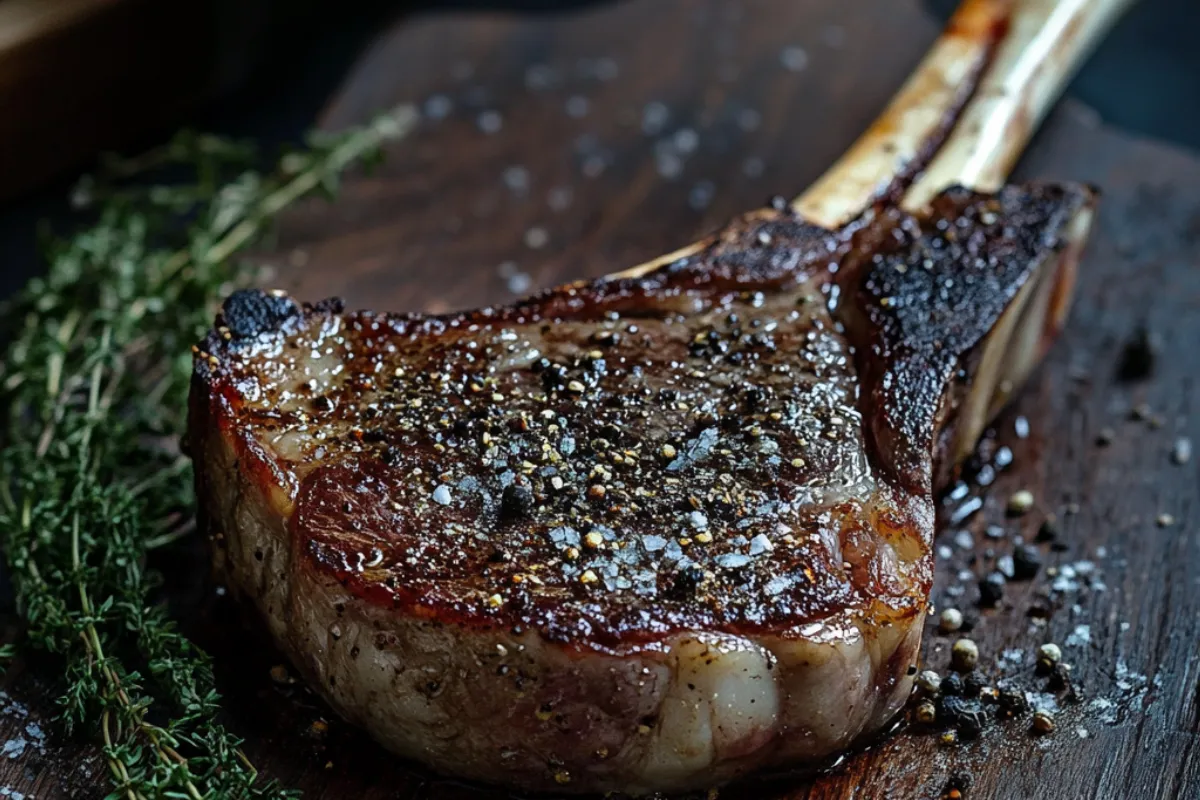A tomahawk steak grabs the attention of meat lovers worldwide due to its impressive look and great taste. This steak cut, with its long rib bone and thick slice of meat, often takes center stage in both fancy restaurants and at-home barbecues. But what exactly makes the tomahawk steak so special? In this article, we will explore its background, how to cook it, its nutritional value, and the reasons behind its rising popularity.

What is So Special About a Tomahawk Steak?
A tomahawk steak is a large, bone-in ribeye steak that includes a long section of the rib bone, giving it its distinctive tomahawk-like appearance. The bone is “frenched,” meaning it is cleaned of meat and fat, leaving a long, handle-like bone that enhances its visual appeal. Typically, a tomahawk steak is about 2 inches thick and weighs between 30 to 45 ounces or more.
The steak comes from the rib section of the cow, which is known for its excellent marbling. This high fat content makes the tomahawk steak exceptionally juicy and flavorful. The bone adds to the steak’s presentation and helps insulate the meat during cooking, keeping it tender and moist.
Tomahawk steaks are often used for special occasions due to their size and striking appearance, making them perfect for sharing or as the centerpiece of a meal. Despite being a ribeye cut, the presence of the bone and its thickness elevate the tomahawk into a unique, premium dining experience.
What is a Tomahawk Ribeye Steak? Why Is It Special?
The tomahawk ribeye steak is essentially a ribeye cut that includes a long section of the rib bone, typically frenched to clean the bone for an elegant look. Its thick cut and impressive bone length give it a weighty presence, often weighing between 30 and 45 ounces. The tomahawk is highly sought after for special occasions due to its premium look and indulgent flavor.
Learn How the Bone Makes a Tomahawk Steak Unique
The bone in a tomahawk steak plays a significant role in both flavor and cooking. It helps regulate heat, keeping the meat juicy during cooking, and many believe that the bone itself imparts extra flavor to the steak. Additionally, the long bone makes the tomahawk steak a dramatic centerpiece, perfect for high-end dinners or gatherings.
Key Features of the Tomahawk Steak:
- Thick Cut: A tomahawk steak is often at least 2 inches thick.
- Bone-In: The rib bone helps boost the flavor and adds to the overall look.
- Marbling: Being a ribeye, the steak has plenty of fat streaks running through it, which makes it juicy and tasty.
The large bone and thick cut make the tomahawk steak weigh anywhere from 30 to 45 ounces or more. Its size and showy look make it great for sharing, and it often acts as the main dish during special events.
Why the Bone Matters
One of the things that makes the tomahawk steak stand out is the rib bone. It does more than just improve the look; it also helps the steak cook more evenly. The bone keeps the heat steady, so the steak stays juicy throughout. Some people believe the bone adds extra flavor, making the tomahawk a popular choice over boneless ribeyes.
The bone also makes the steak visually appealing, making it a favorite at celebrations and fancy dinners. This combination of flavor and style is one reason why the tomahawk steak usually costs more than other cuts.
The Flavor of Marbled Beef
What sets the tomahawk apart is the marbling of fat throughout the meat. This fat melts during cooking, enhancing the steak’s juiciness and depth of flavor. The tomahawk, being a cut from the rib section, has plenty of this marbling, which makes it tender and rich in taste.
For tips on cooking the tomahawk steak to perfection, read about the ultimate guide to enjoying a tomahawk steak.
Why Are Tomahawk Steaks More Expensive?
The tomahawk steak costs more than a regular ribeye for several reasons. The steak’s size and dramatic look play a role, but the way it’s cut also adds to the price. Butchers spend extra time preparing and cleaning the bone, making the tomahawk both labor-intensive and unique.
Here’s a guide on how to buy the best quality steak to help you get the most for your money.
Marbling and Tenderness: Why the Tomahawk Steak Tastes So Good
When choosing a steak, marbling is a key factor in how tender and tasty it will be. Marbling refers to the streaks of fat spread throughout the meat. The tomahawk steak has a lot of marbling, especially if you buy higher-quality beef like USDA Prime or Wagyu.
How Marbling Affects Taste
- Flavor: As the fat melts while cooking, it makes the meat juicy and flavorful.
- Tenderness: The more marbling a steak has, the more tender it will be. This is why the tomahawk is one of the softest cuts of beef.
Compared to leaner steaks like sirloin or filet mignon, the tomahawk offers a richer, more indulgent taste. It’s a favorite for those who enjoy fattier cuts of beef that melt in your mouth.
Best Cooking Methods for Marbled Steaks
Due to its thick size and high-fat content, the tomahawk steak requires careful cooking. The reverse sear method works best for evenly cooking the meat. This process involves cooking the steak slowly at a low temperature and then searing it at high heat to lock in moisture and create a flavorful crust.
For more details on this method, check out this guide on the reverse sear method.
Size and Presentation
Another thing that makes the tomahawk steak stand out is its large size. Weighing over 30 ounces, this cut of beef can easily serve several people. Its size and striking appearance make it a popular choice for special events such as anniversaries, birthdays, and holiday dinners.
Perfect for Sharing
Due to its large size, the tomahawk steak is great for sharing. A single steak can easily feed two to three people, making it ideal for gatherings where you want to impress your guests.
Impressive Presentation
The long rib bone and thick steak create a show-stopping presentation. In restaurants, tomahawk steaks often arrive on large platters, with the bone standing tall and the steak perfectly cooked to a rich, golden brown.
How to Cook a Perfect Tomahawk Steak
Because of its size, cooking a tomahawk steak takes some skill. Whether you’re grilling, pan-searing, or using an oven, it’s essential to keep an eye on the internal temperature to ensure even cooking.
The Reverse Sear Method
This cooking method works well for large cuts like the tomahawk. Start by cooking the steak at a low temperature until the internal temperature reaches around 125°F for medium-rare. Then, sear the steak over high heat to create a crispy crust while keeping the inside juicy.
Grilling Tips
- Use Indirect Heat: Cook the steak over indirect heat most of the time, and then move it to direct heat to finish.
- Resting the Steak: After cooking, allow the steak to rest for 10-15 minutes. This helps keep the meat juicy and tender.
Best Side Dishes
- Carving: Always slice the steak against the grain for maximum tenderness.
- Sides: Pair the tomahawk with roasted veggies, mashed potatoes, or a rich sauce like chimichurri or béarnaise.

Nutritional Breakdown of a Tomahawk Steak
Although delicious, the tomahawk steak is high in calories and fat due to its size and marbling. A 32-ounce steak contains:
- Calories: 2200-2500
- Protein: 150-180 grams
- Fat: Around 180 grams
For those watching their calorie intake, it’s best to share this steak with others and pair it with lighter sides like steamed vegetables or a simple salad.
To learn more about its nutritional content, visit this resource on the nutritional content of a tomahawk steak.
Why Are Tomahawk Steaks So Pricey?
1. Bone-In Presentation
The most obvious feature of a tomahawk steak is its long, frenched rib bone, which makes it look striking on the plate. This bone not only adds weight to the steak but also requires extra time and effort from the butcher to clean and prepare properly. This labor-intensive process raises the cost compared to other boneless cuts, like standard ribeyes.
2. Large Size
Tomahawk steaks are known for their size, often weighing 30 to 45 ounces or more. Due to their thickness, the cut is usually 2 inches or more, meaning you’re buying a substantial amount of meat. More meat means a higher price, and tomahawk steaks are typically served for sharing, further justifying the larger size.
3. Premium Quality Beef
Many tomahawk steaks are sourced from high-quality beef, such as USDA Prime, Angus, or Wagyu varieties, which are known for their exceptional marbling and flavor. The higher the quality of the beef, the more expensive the steak. Cuts like Wagyu tomahawks are particularly pricey due to the rare and highly coveted beef they come from.
4. Luxury and Dining Experience
The tomahawk steak has become a symbol of luxury dining, often found in high-end steakhouses and associated with special occasions. People are willing to pay more for the visual appeal, impressive size, and unique dining experience that a tomahawk steak provides. Its presence at the table, along with the ritual of carving it, adds a sense of indulgence that contributes to its higher price point.
In summary, the combination of expert butchery, premium beef, large size, and luxurious presentation all play a role in making tomahawk steaks a more expensive choice.

Frequently Asked Questions (FAQs)
What makes the tomahawk steak different from a ribeye?
The tomahawk steak is simply a ribeye with the rib bone still attached. The bone gives the steak its unique appearance and can add a bit of flavor during cooking.
Is a tomahawk steak worth the price?
Yes, It is worth it if you’re looking for a high-quality, visually impressive steak. It’s perfect for special occasions and provides a tender, flavorful eating experience.
How should you cook a tomahawk steak?
The reverse sear method is one of the best ways to cook this steak. It ensures even cooking with a crispy crust on the outside.
Can you eat the bone in a tomahawk steak?
No, you can’t eat the bone. However, the bone can add flavor to the meat during cooking, and some people enjoy gnawing on the meat attached to the bone.
Conclusion
In conclusion, the tomahawk stands out as a premium cut of beef, celebrated for its impressive presentation, rich flavor, and indulgent size. Its long bone, tender marbling, and connection to luxury dining experiences contribute to its higher price, making it a symbol of both culinary craftsmanship and indulgence. Whether enjoyed at a high-end restaurant or cooked at home for a special occasion, the tomahawk offers more than just a meal — it provides a memorable dining experience. For meat lovers looking to savor an extraordinary steak, is a cut worth trying.


Excellent post! Your insights on this topic are very valuable and have given me a new perspective. I appreciate the detailed information and thoughtful analysis you provided. Thank you for sharing your knowledge and expertise with us. Looking forward to more of your posts.
Great post! I enjoyed reading it and learned a lot. Your writing style is engaging and easy to follow, and the information you provided was very helpful. Thank you for sharing your knowledge and expertise on this topic. Keep up the good work.